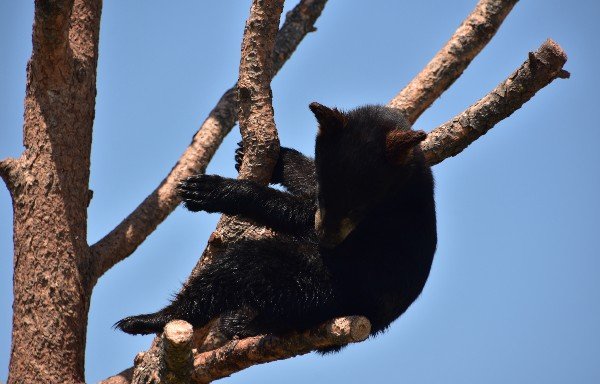Not all bears are considered dangerous, but if there’s one species you should certainly be cautious of, it’s the mighty grizzly. With their enormous size and muscular build, these bears are enough to send a chill down your spine just by their appearance alone; however, it’s not just their physical stature that should concern you, but their capacity for aggression when provoked. Naturally, you may be asking yourself, “How aggressive are grizzly bears?” or “Can they attack, and if so, can they kill a human?” To satisfy your curiosity and answer your questions, let’s dive into the world of these formidable predators.
Grizzly Bears – Identification
Scientifically known as Ursus arctos horribilis, the grizzly bear is one of the most iconic and feared mammals of the wild; these bears are omnivorous by nature, meaning their diet is as versatile as it is opportunistic, consisting of both plant and animal matter. An adult grizzly can weigh anywhere between 800 and 1,000 pounds, and despite their daunting size, they have an impressive lifespan of up to 25 years, particularly in their North American habitats. Grizzlies are often recognized by their characteristic brown fur, which sets them apart from other bear species, though it’s worth noting that their fur can have white-tipped strands, giving them a “grizzled” appearance that perhaps inspired their common name.
Grizzlies as Predators
Grizzly bears sit comfortably at the apex of the food chain, making them top-tier predators in virtually every ecosystem they inhabit. While much of their diet includes leaves, berries, fruits, roots, and nuts, these massive creatures can also prey on smaller mammals such as rodents and, when the opportunity presents itself, even large animals like moose. Grizzlies, despite their colossal size, are surprisingly agile and can reach speeds of up to 30 miles per hour; their incredible endurance and ability to cover vast distances make them capable of being both sprinters and marathoners. However, the true threat from a grizzly arises not just from its physical attributes but from its fierce temperament—particularly when startled or when its cubs are perceived to be in danger.
The Reality of Grizzly Bear Aggression
In the wild, grizzly bears are counted among the most dangerous animals; they possess not only immense physical power but also an extraordinarily strong bite force of approximately 1,000 pounds per square inch, which is enough to crush bone and sever flesh with ease. However, while they are undoubtedly deadly, grizzlies typically do not attack unless provoked, surprised, or in defense of their offspring. Female grizzlies, known for their protective nature, are especially aggressive when they perceive a threat to their cubs; they will not hesitate to charge at anything they deem a danger, whether it be another animal or an unwary human.
Grizzly Bear Adaptations That Make Them Lethal
One of the most astonishing traits of grizzlies is their ability to maintain high speeds for extended periods of time; this means that whether you are an experienced sprinter or marathon runner, the chances of outrunning a grizzly are virtually nonexistent. Grizzly bears rank as the second fastest bear species in the world, able to sprint across 100 yards in just eight seconds, a feat that makes them faster than the average dog. Furthermore, their sheer agility and immense strength make them a force to be reckoned with; a grizzly bear, when standing upright, may not seem immediately threatening, but one should never be lulled into a false sense of security. Weighing up to 1,300 pounds, a grizzly can lift and throw an animal weighing over 1,000 pounds a significant distance; their sharp claws are another deadly asset, capable of inflicting crippling injuries on nearly any opponent.
Unmatched Bite Force
In terms of raw power, grizzlies boast one of the most formidable bite forces in the entire animal kingdom. Their jaws can exert a pressure of up to 1,000 pounds per square inch, allowing them to crush and consume even the hardest objects—reports suggest that their bite is so powerful, it could crush something as solid as a bowling ball. This incredible strength, combined with their naturally aggressive tendencies, makes grizzly bears truly one of the most dangerous animals humans could encounter in the wild.
Grizzlies’ Solitary Nature
Unlike lions and other social predators that often rely on teamwork or pride dynamics, grizzly bears prefer a solitary existence. They are lone hunters, spending the majority of their time roaming vast expanses of wilderness in search of food or mates; they fiercely guard their personal space, which means they can react aggressively if another animal, or worse, a human, unknowingly crosses into their territory. This solitary nature is one of the reasons grizzly bears can be particularly dangerous—encountering one unexpectedly in the wild increases the risk of an aggressive response, as the bear may feel threatened in its personal domain.
Visit Yellowstone Bear World
Given all these incredible and sometimes terrifying facts about grizzlies, it’s clear that you should exercise extreme caution if you plan to venture into their natural habitat. Now that you understand the dangers posed by these powerful animals, it’s essential to take precautions if you’re planning a hike or picnic in bear country; always consult with park rangers or wildlife experts for safety advice. Better yet, if you’re interested in learning more about grizzlies while staying safe, visit Yellowstone Bear World, where you can experience these magnificent creatures in a controlled environment and learn more about their behavior and lifestyle. Call us today at (208) 359-9688 to plan your visit!






